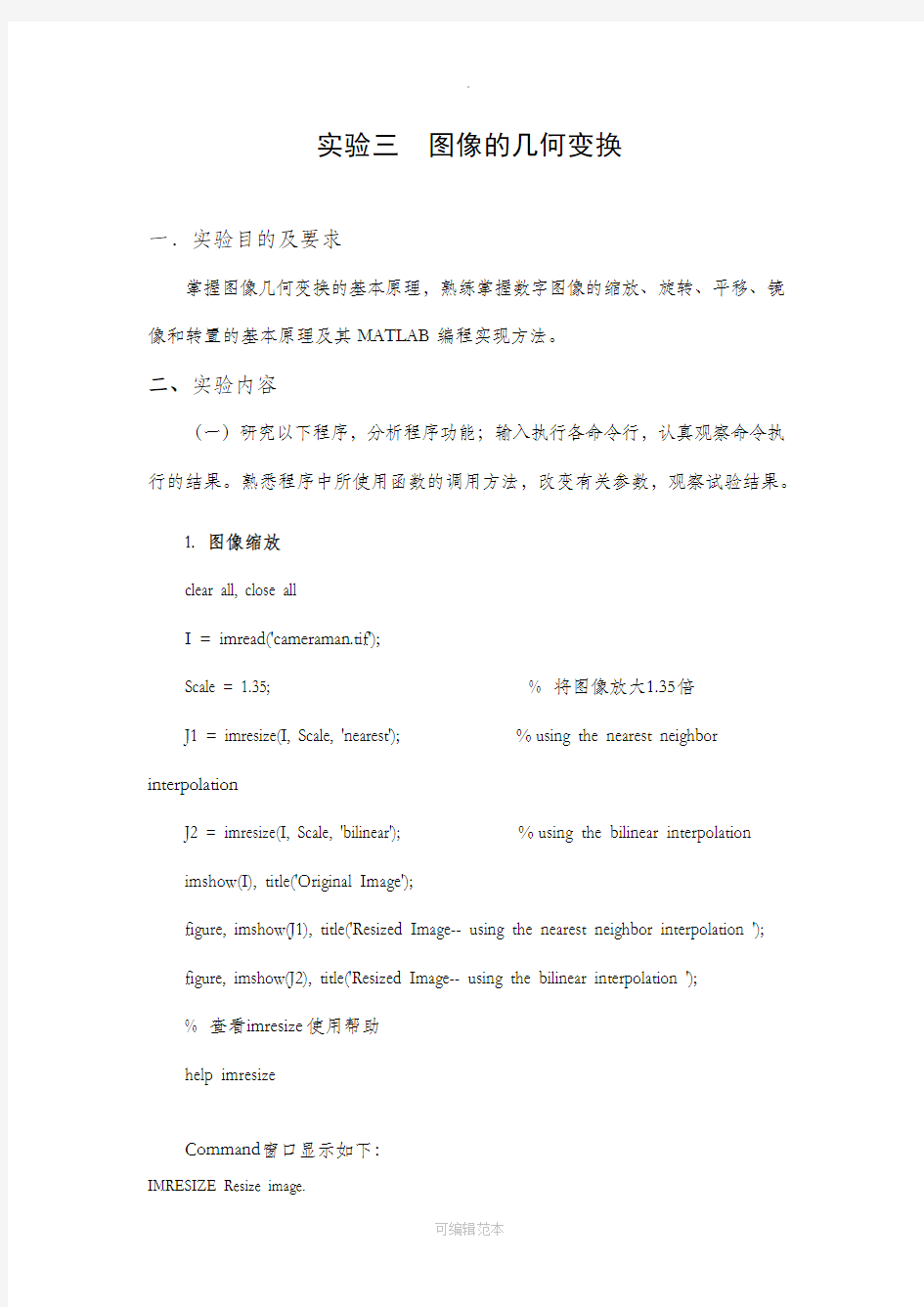数字图像处理实验报告(三四五)

- 1、下载文档前请自行甄别文档内容的完整性,平台不提供额外的编辑、内容补充、找答案等附加服务。
- 2、"仅部分预览"的文档,不可在线预览部分如存在完整性等问题,可反馈申请退款(可完整预览的文档不适用该条件!)。
- 3、如文档侵犯您的权益,请联系客服反馈,我们会尽快为您处理(人工客服工作时间:9:00-18:30)。
实验三图像的几何变换
一.实验目的及要求
掌握图像几何变换的基本原理,熟练掌握数字图像的缩放、旋转、平移、镜像和转置的基本原理及其MATLAB编程实现方法。
二、实验内容
(一)研究以下程序,分析程序功能;输入执行各命令行,认真观察命令执行的结果。熟悉程序中所使用函数的调用方法,改变有关参数,观察试验结果。
1. 图像缩放
clear all, close all
I = imread('cameraman.tif');
Scale = 1.35; % 将图像放大1.35倍
J1 = imresize(I, Scale, 'nearest'); %using the nearest neighbor interpolation
J2 = imresize(I, Scale, 'bilinear'); %using the bilinear interpolation
imshow(I), title('Original Image');
figure, imshow(J1), title('Resized Image-- using the nearest neighbor interpolation ');
figure, imshow(J2), title('Resized Image-- using the bilinear interpolation ');
% 查看imresize使用帮助
help imresize
Command窗口显示如下:
IMRESIZE Resize image.
B = IMRESIZE(A, SCALE) returns an image that is SCALE times the
size of A, which is a grayscale, RGB, or binary image.
B = IMRESIZE(A, [NUMROWS NUMCOLS]) resizes the image so that it has
the specified number of rows and columns. Either NUMROWS or NUMCOLS may be NaN, in which case IMRESIZE computes the number of rows or
columns automatically in order to preserve the image aspect ratio.
[Y, NEWMAP] = IMRESIZE(X, MAP, SCALE) resizes an indexed image.
[Y, NEWMAP] = IMRESIZE(X, MAP, [NUMROWS NUMCOLS]) resizes an indexed image.
To control the interpolation method used by IMRESIZE, add a METHOD argument to any of the syntaxes above, like this:
IMRESIZE(A, SCALE, METHOD)
IMRESIZE(A, [NUMROWS NUMCOLS], METHOD),
IMRESIZE(X, MAP, M, METHOD)
IMRESIZE(X, MAP, [NUMROWS NUMCOLS], METHOD)
METHOD can be a string naming a general interpolation method:
'nearest' - nearest-neighbor interpolation
'bilinear' - bilinear interpolation
'bicubic' - cubic interpolation; the default method
METHOD can also be a string naming an interpolation kernel:
'box' - interpolation with a box-shaped kernel
'triangle' - interpolation with a triangular kernel
(equivalent to 'bilinear')
'cubic' - interpolation with a cubic kernel
(equivalent to 'bicubic')
'lanczos2' - interpolation with a Lanczos-2 kernel
'lanczos3' - interpolation with a Lanczos-3 kernel
Finally, METHOD can be a two-element cell array of the form {f,w},
where f is the function handle for a custom interpolation kernel, and
w is the custom kernel's width. f(x) must be zero outside the
interval -w/2 <= x < w/2. Your function handle f may be called with a scalar or a vector input.
You can achieve additional control over IMRESIZE by using
parameter/value pairs following any of the syntaxes above. For example:
B = IMRESIZE(A, SCALE, PARAM1, VALUE1, PARAM2, VALUE2, ...) Parameters include:
'Antialiasing' - true or false; specifies whether to perform
antialiasing when shrinking an image. The
default value depends on the interpolation
method you choose. For the 'nearest' method,
the default is false; for all other methods,
the default is true.
'Colormap' - (only relevant for indexed images) 'original'
or 'optimized'; if 'original', then the
output newmap is the same as the input map.
If it is 'optimized', then a new optimized
colormap is created. The default value is
'optimized'.
'Dither' - (only for indexed images) true or false;
specifies whether to perform color
dithering. The default value is true.
'Method' - As described above
'OutputSize' - A two-element vector, [MROWS NCOLS],
specifying the output size. One element may
be NaN, in which case the other value is
computed automatically to preserve the aspect
ratio of the image.
'Scale' - A scalar or two-element vector specifying the
resize scale factors. If it is a scalar, the
same scale factor is applied to each
dimension. If it is a vector, it contains
the scale factors for the row and column
